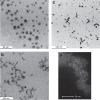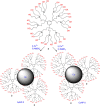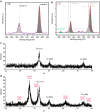Precise localization of metal nanoparticles in dendrimer nanosnakes or inner periphery and consequences in catalysis
- PMID: 27759006
- PMCID: PMC5075800
- DOI: 10.1038/ncomms13152
Precise localization of metal nanoparticles in dendrimer nanosnakes or inner periphery and consequences in catalysis
Abstract
Understanding the relationship between the location of nanoparticles (NPs) in an organic matrix and their catalytic performances is essential for catalyst design. Here we show that catalytic activities of Au, Ag and CuNPs stabilized by dendrimers using coordination to intradendritic triazoles, galvanic replacement or stabilization outside dendrimers strongly depends on their location. AgNPs are found at the inner click dendrimer periphery, whereas CuNPs and AuNPs are encapsulated in click dendrimer nanosnakes. AuNPs and AgNPs formed by galvanic replacement are larger than precursors and only partly encapsulated. AuNPs are all the better 4-nitrophenol reduction catalysts as they are less sterically inhibited by the dendrimer interior, whereas on the contrary CuNPs are all the better alkyne azide cycloaddition catalysts as they are better protected from aerobic oxidation inside dendrimers. This work highlights the role of the location in macromolecules on the catalytic efficiency of metal nanoparticles and rationalizes optimization in catalyst engineering.
Figures







Similar articles
-
Click dendrimers and triazole-related aspects: catalysts, mechanism, synthesis, and functions. A bridge between dendritic architectures and nanomaterials.Acc Chem Res. 2012 Apr 17;45(4):630-40. doi: 10.1021/ar200235m. Epub 2011 Dec 8. Acc Chem Res. 2012. PMID: 22148925 Review.
-
"Click" synthesis of nona-PEG-branched triazole dendrimers and stabilization of gold nanoparticles that efficiently catalyze p-nitrophenol reduction.Inorg Chem. 2014 Jul 7;53(13):6954-61. doi: 10.1021/ic500861f. Epub 2014 Jun 9. Inorg Chem. 2014. PMID: 24910892
-
Copper Nanoparticles in Click Chemistry.Acc Chem Res. 2015 Sep 15;48(9):2516-28. doi: 10.1021/acs.accounts.5b00293. Epub 2015 Sep 2. Acc Chem Res. 2015. PMID: 26332570
-
Magnetic and dendritic catalysts.Acc Chem Res. 2015 Jul 21;48(7):1871-80. doi: 10.1021/acs.accounts.5b00039. Epub 2015 Jun 22. Acc Chem Res. 2015. PMID: 26098668
-
Core and periphery functionalized dendrimers for transition metal catalysis; a covalent and a non-covalent approach.J Biotechnol. 2002 May;90(3-4):159-81. doi: 10.1016/s1389-0352(01)00059-9. J Biotechnol. 2002. PMID: 12071224 Review.
Cited by
-
Amphiphilic Polymeric Nanoparticles for Photoredox Catalysis in Water.Chemistry. 2020 Aug 12;26(45):10355-10361. doi: 10.1002/chem.202001767. Epub 2020 Jul 22. Chemistry. 2020. PMID: 32428312 Free PMC article.
-
Fabrication of Cu@Ag core-shell/nafion/polyalizarin: Applications to simultaneous electrocatalytic oxidation and reduction of nitrite in water samples.Heliyon. 2024 Dec 7;11(1):e40979. doi: 10.1016/j.heliyon.2024.e40979. eCollection 2025 Jan 15. Heliyon. 2024. PMID: 39790879 Free PMC article.
-
Advances in Matrix-Supported Palladium Nanocatalysts for Water Treatment.Nanomaterials (Basel). 2022 Oct 13;12(20):3593. doi: 10.3390/nano12203593. Nanomaterials (Basel). 2022. PMID: 36296782 Free PMC article. Review.
-
Heterogeneous Dendrimer-Based Catalysts.Polymers (Basel). 2022 Feb 28;14(5):981. doi: 10.3390/polym14050981. Polymers (Basel). 2022. PMID: 35267800 Free PMC article. Review.
-
Synthesis of graphene quantum dot-stabilized gold nanoparticles and their application.RSC Adv. 2019 Jul 9;9(37):21215-21219. doi: 10.1039/c9ra02758k. eCollection 2019 Jul 5. RSC Adv. 2019. PMID: 35521309 Free PMC article.
References
-
- Schmid G. (ed.) Nanoparticles: From Theory to Application. Wiley-VCH (2004).
-
- Brongersma M. L., Halas N. J. & Nordlander P. Plasmon-induced hot carrier science and technology. Nat. Nanotechnol. 10, 25–34 (2015). - PubMed
-
- Daniel M.-C. & Astruc D. Gold nanoparticles: assembly, supramolecular chemistry, quantum-size-related properties, and applications toward biology, catalysis, and nanotechnology. Chem. Rev. 104, 293–346 (2004). - PubMed
-
- Haruta M. & Date M. Advances in the catalysis of Au nanoparticles. Appl. Cat. A- Gen. 222, 427–437 (2001).
LinkOut - more resources
Full Text Sources
Other Literature Sources
Molecular Biology Databases

